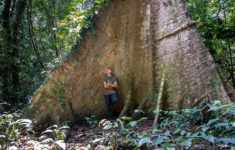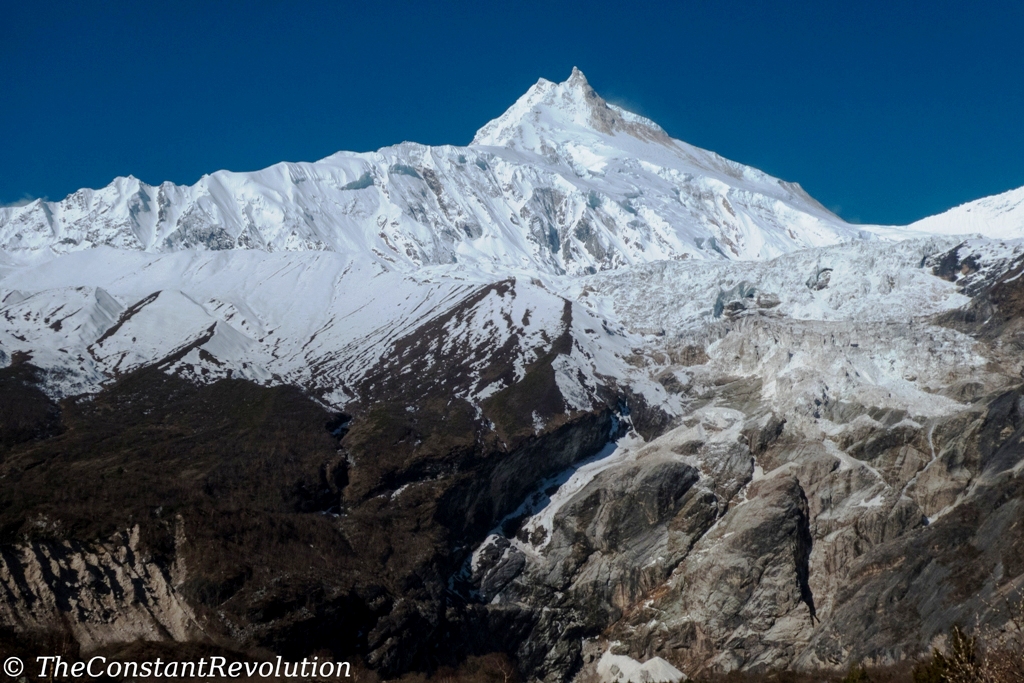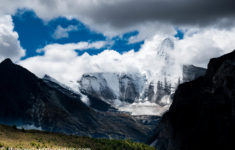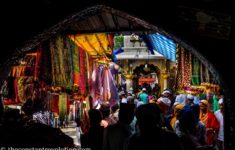A local community gets organised and finds a way to fund conservation and reforestation programs through their Eco-tourism, providing at the same time a viable alternative to palm oil jobs. An amazing place to find some quiet and spot the incredible Borneo’s wildlife, KOPEL’s Pin-Supu Forest Conservation Area is with no doubt a success story in sustainability, and an example to follow.
At the junction between the Kinabatangan river and the main road that travels through Sabah, in Malaysian Borneo, between Sandakan and Lahad Datu, rests the small village of Batu Puteh, with about 2,000 inhabitants. Here, a community-based project has been set up to take care of the Pin-Supu Forest Conservation Area, 4,700 hectares of lowland rainforest, home of the whole range of Borneo’s wildlife, with the river on one side and the beautiful Tungog Lake at its heart (featured image).

The offices of the Batu Puteh Community Ecotourism Cooperative (KOPEL) are to be found right under the bridge built across the Kinabatangan. It’s a wide area with a restaurant over the river, many wooden decks for the logistics and cultural performances, a couple of volleyball nets set up for recreation, and the jetty from where all adventures start. Indeed, moving to one of the two Eco-camps from the headquarters can be done only with a boat ride on the river.
I spent about a month at the Eco-camp in front of the Tungog lake, working as a volunteer with locals, mostly helping with the reforestation program. I wrote about the amazing experience as a volunteer and the possibility for wildlife spotting along the Kinabatangan river in different posts.
Here, I really want to focus on what KOPEL does, as I had the chance to discuss their work in details with many local employees and Martin Vogel, the General Manager of the project.

The link between protecting the environment, providing an alternative to oil plantation jobs, and self-funding conservation and reforestation programs through Eco-tourism, is what makes KOPEL one of the most interesting, effective sustainability projects I have ever come across. Yet, there are some risks in tying conservation programs to Eco-tourism business which must be kept in mind.
Before I provide all the info about their conservation work and the activities for tourists, a short overview of Sabah’s economic development over time will put this project into the context of today’s world.
If you are only interested in the practical information, just scroll down to the last paragraph 😉
IS PALM OIL EVIL?
When you travel on the road between Sandakan and Semporna, in Sabah, you might think that the entire area is a palm oil plantation. Indeed, that’s pretty much all you can see all around these flat and fertile flood-lands in the Eastern part of the region.
But the reality is a little different from perception. In Sabah, 50% of the land is Forest Reserves (or secondary forest, like the Pin-Supu Forest Conservation Area), 10% is National Parks, and 40% is used for farming. This 40% is highly concentrated in farmable areas, easy to travel by road too, hence the often-deceptive view that there is only farmland left whilst driving overland on the east coast of Sabah. The rest of the territory is too mountainous and rocky, and therefore difficult to farm.

Today, the logging has pretty much stopped, and regulations are finally being put in place to protect both environment and wildlife by the government. This might not be the case for other regions in Borneo, where there are battles still to be fought to stop logging from further destroying the environment.
In Sabah, the challenge is of a different kind: without logging and oil plantations, which have dominated the economic activity for decades, what are the locals supposed to do for a living?
It’s pretty clear that 40% of farming land will not go back to the forest, or just a very small part of it will. No matter what is farmed, people will farm it. The evil is not palm oil as such, not now in Sabah. That is just the most effective production that has been put into place. If it wasn’t palm oil the same land would be farmed with some other plantations or crops, most likely harder to grow, with a host of other consequences for the environment.
Rather, the local economy has been a victim of mankind’s rapid development, which has drastically changed the lifestyles of the people living in places like Sabah’s jungles. If any evil has to be found, we should look to our own history, development, and modern lifestyles.
How Sabah’s economy changed since the 1950s
Sabah’s economy started to see a major transformation in the 1950s with the arrival of mechanization in logging (by 1964 as many as 10,000 bulldozers where operating in the area), and then intensive farming experimentation in the 70s and 80s. Rubber, cacao, then the realization that palm oil is the most productive of all, with monthly harvests throughout the year.
Malaysia at that time was on a fast-developing curve, and the only place in the world investing so intensively in palm oil. This competitive advantage made the choice for this type of plantation obvious.
All these changes had a strong impact on locals, who had previously lived for 1,000 years out of what the jungle would naturally provide and traded with the outside world with forest products such as valuable resins, incense woods, medicinal products, edible bird nests (made by two species of swift-lets, a bird endemic to this area), and wild spices such as cinnamon.

Some incense woods such as Agarwood is very rare today, trading at extremely high prices, while the rare edible bird nests are also a very expensive traditional rainforest product. The trade of these edible bird nests is actually one of the main reasons why the Pin-Supu Forest Conservation Area exists. It isn’t for the protection of the environment or wildlife, but for the protection of (traditional) economic interests that the area was saved from logging.
It’s a bitter irony, but perhaps there is no escape to this thinking, it is in the nature of men, and the only way to go about finding solutions is to find economic interest in protecting the environment.
Be it as it may, all the changes in the economy over time obliged locals to leave behind their traditional lifestyles and work for one industry or the other to make a living.
Surprisingly, while in the 1980s the lowland forests along the east coast of Sabah were being opened for agriculture, small but important forested areas were being protected as forest reserves or sanctuaries for wildlife along the Kinabatangan River. Hence today a small patchwork of forests still buffers the Lower Kinabatangan River. All these forest patches combined form the last remaining habitat for Borneo’s incredible biodiversity, and are arguably the best places to observe wildlife.

The rapid transformation of the local economy alongside the depletion of traditional forest resources, spurred many people to go looking for better opportunities in nearby cities. Moves to lock-up the remaining forests as “protected areas” exacerbate the harsh economic reality for locals, who lose all access to traditional resources in this process.
If necessity is the mother of invention, then the loss of resources, loss of livelihoods, loss of traditional culture, the loss of language, and the ensuing loss of a younger generation of educated and outward thinking people, the locals left behind started to dream about alternatives, such as make a living out of tourism.
It is in this context that KOPEL was set up, in the mid-90s, with the objective to work for a more sustainable future for local people by conserving and creating economic value out the incredible biodiversity of the Pin-Supu Forest Conservation – without chopping it down.
TOUGH CONSERVATION WORK
In the late 90s for various reasons, including climate change and changes in micro-climates due to deforestation, many forest areas have suffered severe degradation due to forest fires. It was an ecological disaster of global proportions. These areas badly needed restoration, and in many cases reforestation.
This is where the community co-op KOPEL has established something unique in this part of Borneo, by dealing with a huge restoration and reforestation program. Between 1999 and 2019 KOPEL has planted more than 350,000 trees. Today, the full range of Borneo wildlife lives in the Pin-Supu Forest Conservation Area. Certainly a huge achievement, but it hasn’t been easy.

The Kinabatangan river and floodplain have several micro topographies, being partially or totally flooded in different periods of the year. Because of this, there are many changes in the types of plants inhabiting the forests across the floodplain. For example, the plants are very peculiar a short distance from the river, whereas moving inland and away from the river the mix of plants and species changes depending on whether the areas are waterlogged or on high ground where the water cannot reach.
For this reason, replanting programs have been time-consuming and wrought with failure. There has been a lot of trials and learning from mistakes, before understanding the right techniques for these unique forest habitats. An important step was to understand which trees grow better from wild natural regeneration, and which ones work better by planting. Ultimately the biggest lessons have been that the follow-up maintenance, which involves chopping vines that strangle the growing trees, is one of the most important parts of the tree planting process.
Now that I have helped with this myself it is so much easier to see how difficult this work really is. I helped KOPEL recovering a small pocket of land between the river banks and an oil palm plantation, perhaps 50 or 100 m wide. By reforesting these areas the hope is to create corridors that connect the different wildlife habitat, or pockets of forests along the Kinabatangan and provide wider areas for wildlife to source food.

Fun fact: the forest in Borneo grows 360 days per year. Many trees don’t even have growth rings as rings are formed when a tree’s growth slows down, or speeds up, due to seasonality. In this part of Borneo, harsh seasonality that could form growth rings, only occurs every 15 to 20 years, when there is a very dry season in this area. During these times, many trees change their colour and drop their leaves. It’s like autumn in the rainforest, and it is only at these times the growth of trees slows down. For this reason, it is very hard to establish the age of trees in Borneo.
Survival of the Tungog lake
In addition to monitoring and reforestation, another major program KOPEL is running is to get rid of an invasive water weed in Tungog lake (featured image).
The weed known as Salvinia molesta comes from South-East Brazil. Outside its home range, there are no natural predators that eat this weed, so it spreads unchecked and out of control. This weed has become a severe problem in several parts of the world, especially in equatorial countries. The plant floats on water, getting all the nutrients and sunlight it needs without competition from other species. This crazy plant doubles in size every 3 to 5 days until it eventually covers the entire surface of the lake. After it completely covers the lake’s surface it slowly suffocates the life out of the lake, effectively killing anything that lives in those waters.
In biodiverse hotspots such as Borneo, the freshwater lakes are extremely important for aquatic biodiversity, with many aquatic dependent birds and wildlife relying on these fast-shrinking habitats for their survival. What is astonishing is that this small community organisation KOPEL has been working for more than 10 years to rid the lake of this choking week. This is an enormous endeavour.

For now, only a small part of the lake can be kept clean, just in front of the Eco-Camp. This relies completely on manual labour and hard physical efforts of locals, visiting schools and volunteers.
Some other options to solve this issue are currently being trialled. The most promising one is using a bio-control, which involves introducing a non-invasive species of beetle that eats the weed. Even so, it takes years for this to happen, if at all successful. So, for now, KOPEL has to rely on its own, scarce resources, to deal with this environmental disaster.
THE ALTERNATIVE SELF-FUNDING THROUGH ECO-TOURISM
The fact is that all KOPEL’s conservation work is entirely self-funded, and tied to its Eco-tourism business. While this is an amazing accomplishment, and an example to follow worldwide, it comes with some risks for long term conservation. In many ways, it does not provide enough resources to upskill or upscale the work and have a greater impact.

For example, as much as 30% of KOPEL’s annual revenue goes into the forest and lake restoration efforts. Even so, there is still not enough money to acquire machines that would allow working faster and more effective, so everything needs to be done by hand or with small boats, which is slow and gruelling work.
New jobs for the community
Through its community-based Eco-tourism programs, KOPEL has created new jobs for locals, as an alternative to working for palm oil plantation. This is not only for the jungle guides or staff working in the accommodation facilities, but also for the people working in the office, at the restaurant, and many other conservation activities linked to the work.
In Batu Puteh, more than 100 villagers make a living out of this community co-op. This reduces the need to move to a city to look for a job, or even worse end up in the illegal pet trade or poaching business.

This is a great way to create economically viable alternatives for local communities while working towards a better future, effectively responding to the challenges of today’s world.
Changes the world needs
One problem remains: relying on Eco-tourism alone does not provide huge resources for conservation work. This and many other issues could probably be solved with more resources, for example with a mixed business model that relies on the income from Eco-tourism as well as some funding from the state or international organization working on conservation.
Some work is being done in that direction, with a possible project which would involve the use of renewable energy for the Eco-Camps paired with a training program for locals, including those not employed by KOPEL.
Sadly, the necessary time and know-how to look for donors or chase for grants is unreachable in such a small locally oriented project. And yet, it is exactly projects like this that bring about the changes the world badly needs: KOPEL works for the protection of Sabah’s forest and its long-term sustainability. Most importantly, it helps to create a new feeling of belonging in small communities such as Batu Puteh and a new, greener way of looking at their work and lifestyles.
THE ECO-TOURISM ACTIVITIES WITH KOPEL
The Pin-Supu Forest Conservation Area is a much cheaper, Eco-friendly, and quiet alternative to other touristic spots along the Kinabatangan river to have a taste of the incredible Borneo’s rainforest. In the better-known town of Sukau for example, many lodges, B&B, home stays, and tour operators work at the same time. In Batu Puteh, there is only KOPEL operating both for accommodations and river cruises.

I can guarantee that the full range of Borneo wildlife can be spotted here just like elsewhere, the locals (guides and others) are simply amazing people, and the Eco-camp is an unforgettable place.
So what can you do at the Pin-Supu Forest Conservation Area:
√ Accommodations
There are two alternatives: a homestay in the village, or staying at the Eco-camp in front of Tungog lake. The Eco-camp has no electricity and uses bucket cold showers, but it is right in the middle of the jungle. A number of wooden made decks are available with single or double simple rooms (just a mattress on a wooden bunk) with mosquito nets, and a bathroom.
Food is brought back and forth from the café in the village, and it’s super tasty with loads of variety. The place is stunning and highly recommended for all nature and wildlife lovers. Just by hanging out there you can see many birds, monkeys, squirrels, and some other regular visitors such as a big monitor lizard, a Buffy fish owl, a Malay civet or a Mouse deer. Cool stuff!
√ Jungle treks
The very knowledgeable, keen-eyed wildlife spotting guides can take you through several trails in the jungle, including an interesting trek around the lake. Night walks are a must do. You might spot some snakes, frogs, owls, mouse deer, civets and other nocturnal mammals. With a bit of luck, you might be able to see the elusive slow loris, one of the three apes in Borneo with Orangutans and Gibbons, or the super cute western tarsier, a very small, big-eyed nocturnal monkey. During my time there, I saw it all. A memorable moment has been a morning solitary walk in the jungle around camp, when I have seen and orangutan mother with her baby, and could observe their behaviour in nature for about 20 minutes. Pure magic!
√ River cruises
Sunrise and sunset cruises on the Kinabatangan river are easy, lots of fun, and do not disappoint. Regular sights include the Bornean endemic Proboscis monkey, estuarine saltwater crocodiles that can grow up to 6m long, Hornbills (there are 7 types of them), Kingfishers, Bee-eaters and many other birds, and if you are lucky, of course, the Orangutan. A great classic!

√ Supu camp and cave exploration
KOPEL also runs a second camp upriver, called Supu Camp. This is a lot more spartan than the one by Tungog Lake. From the Supu Camp, it is possible to organise visits to some caves inhabited by bats and other spooky creatures, such as tarantulas and long-legged centipedes. You can also climb to the top of the limestone outcrops to check a most beautiful, misty sunrise. If you are up for a night over and a very early rise that is 😉

√ Tree planting
This is KOPEL’s signature: if you wish to contribute to the reforestation, you have the possibility to plant your own tree(s). It gives a special feeling of satisfaction to plant new trees, there’s nothing more to add.
√ Education programs
If you are a school you can organise multi-day workshops, activities and educational programs with KOPEL for your students. This includes the whole range of activities described above and normally ends up with some kind of presentation night from the students and a cultural performance from the locals. I couldn’t think of a better place to take my students. In my time there I have seen both a Japanese and an International school in action, and I can tell for these boys and girls it was like discovering an entirely new world. They had an amazing time.

√ Volunteering
If you are up for a longer stay, and you don’t mind some hard work under the warmth of the tropical sun, then you can do like me and stay for a volunteering experience. It is definitely the best I have done in my life: KOPEL staff welcomed me like in a family, I have learnt a lot about the Borneo’s rainforest and conservation work, I felt very useful and this is definitely a worthwhile project, and, icing on the big cake, I have spotted so much wildlife. I basically threw myself in the jungle at every occasion, camera firmly grasped in my hands 🙂
HOW TO GET THERE
Here is the link to get in touch with KOPEL.
In any case, getting there is pretty simple, if you are travelling on the road from Kota Kinabalu (or Sandakan) down to Lahad Datu or Semporna (it’s the same road), or vice-versa, you can ask the bus driver to drop you at the junction between the road and the bridge that crosses the Kinabatangan River. There is only one bridge, and the office is just under it.
Sometimes bus drivers would know where it is, just mention Kinabatangan KOPEL. The minibus would take you straight to the office, while the big buses would leave you few hundred metres back on the main road.
KOPEL Reception Centre is also indicated on Maps.me or Google map.







